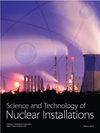Verification of the Efficacy of Passive Autocatalytic Recombiners in a Typical Pressurized Water Reactor under a Station Blackout Condition
IF 0.9
4区 工程技术
Q3 NUCLEAR SCIENCE & TECHNOLOGY
引用次数: 0
Abstract
The presence of a stable stratified gas cloud inside the containment near or at the flammability limit may lead to deflagration or even detonation which may challenge the containment and cause a radioactive material release into the environment. To mitigate this risk, a number of approaches have been proposed, for example, containment inerting or venting and use of passive autocatalytic recombiners or igniters. However, for these measures to be effective, a thorough analysis of the hydrogen dispersion and associated phenomena is indispensable during the design phase as well as the mitigation phase during a severe accident. In this work, a MAAP analysis is performed to assess the hydrogen risk in a typical pressurized water reactor (PWR) containment. An extended station blackout (SBO) was chosen as an initiating event given its high contribution to the core damage frequency. RCS depressurization and external injection are mitigation techniques implemented consecutively to extend the coping capability of the plant for the extended SBO scenario. A sensitivity study is performed to select the combination of timing and flow rate that generate the most severe case for the “in-vessel phase of hydrogen generation.” Subsequently, a number of passive autocatalytic recombiners (PARs) were implemented to mitigate the hydrogen risk during the first three days of the accident. The Shapiro diagram is used to assess the flammability condition of the containment atmosphere based on MAAP analysis. The results show that the gas mixture composition is acceptable in the majority of the containment compartments and only marginally acceptable in the cavity. Even under the conservative conditions of the accident, the simulation results confirmed the sufficiency of recombiners alone without igniters in the low hydrogen concentration zones, while for compartments close to the sources, additional mitigation may be needed.电站停电条件下典型压水反应堆中非能动自催化复合器的有效性验证
安全壳内接近或处于可燃极限的稳定分层气体云可能导致爆燃甚至爆炸,这可能会挑战安全壳并导致放射性物质释放到环境中。为了减轻这种风险,已经提出了许多方法,例如,安全壳惰性化或排气以及使用被动自催化复合器或点火器。然而,为了使这些措施有效,在设计阶段以及严重事故期间的缓解阶段,对氢气扩散和相关现象进行彻底分析是必不可少的。在这项工作中,进行了MAAP分析,以评估典型压水堆(PWR)安全壳中的氢气风险。考虑到延长电站停电(SBO)对堆芯损坏频率的贡献很大,因此选择其作为启动事件。RCS降压和外部注入是连续实施的缓解技术,以扩展核电站在扩展SBO场景下的应对能力。进行了敏感性研究,以选择产生“容器内制氢阶段”最严重情况的时间和流速组合。随后,在事故发生的前三天,实施了一些非能动自催化复合器(PAR),以降低氢气风险。夏皮罗图用于基于MAAP分析评估安全壳大气的可燃性条件。结果表明,气体混合物成分在大多数安全壳隔间中是可接受的,而在空腔中只是勉强可接受的。即使在事故的保守条件下,模拟结果也证实了在低氢浓度区单独使用复合器而不使用点火器的充分性,而对于靠近源的隔间,可能需要额外的缓解措施。
本文章由计算机程序翻译,如有差异,请以英文原文为准。
求助全文
约1分钟内获得全文
求助全文
来源期刊

Science and Technology of Nuclear Installations
NUCLEAR SCIENCE & TECHNOLOGY-
CiteScore
2.30
自引率
9.10%
发文量
51
审稿时长
4-8 weeks
期刊介绍:
Science and Technology of Nuclear Installations is an international scientific journal that aims to make available knowledge on issues related to the nuclear industry and to promote development in the area of nuclear sciences and technologies. The endeavor associated with the establishment and the growth of the journal is expected to lend support to the renaissance of nuclear technology in the world and especially in those countries where nuclear programs have not yet been developed.
 求助内容:
求助内容: 应助结果提醒方式:
应助结果提醒方式:


